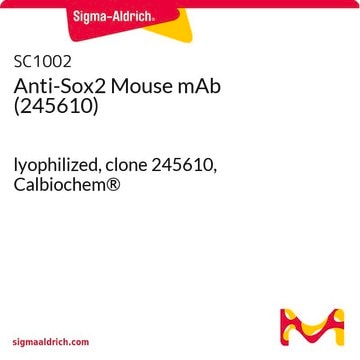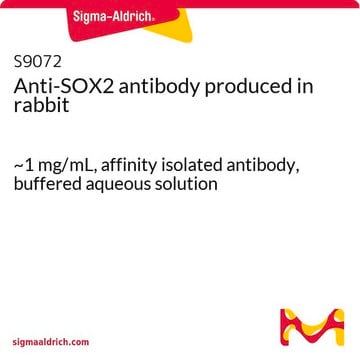S1451
Anti-Sox2 antibody, Mouse monoclonal
clone SOX2-6, purified from hybridoma cell culture
Synonym(e):
Anti-ANOP3, Anti-MCOPS3, Anti-SRY (sex determining region Y)-box 2, Anti-SRY-related HMG-box gene 2, Anti-Sex-determining region Y-box 2
About This Item
Empfohlene Produkte
Biologische Quelle
mouse
Konjugat
unconjugated
Antikörperform
purified from hybridoma cell culture
Antikörper-Produkttyp
primary antibodies
Klon
SOX2-6, monoclonal
Form
buffered aqueous solution
Mol-Gew.
antigen ~35 kDa
Speziesreaktivität
human, mouse
Konzentration
~1.0 mg/mL
Methode(n)
western blot: 0.5-1.0 μg/mL using whole extract of human NT2 cells
Isotyp
IgG1
UniProt-Hinterlegungsnummer
Versandbedingung
dry ice
Lagertemp.
−20°C
Posttranslationale Modifikation Target
unmodified
Angaben zum Gen
human ... SOX2(6657)
mouse ... Sox2(20674)
rat ... Sox2(499593)
Allgemeine Beschreibung
Anwendung
Biochem./physiol. Wirkung
Physikalische Form
Haftungsausschluss
Sie haben nicht das passende Produkt gefunden?
Probieren Sie unser Produkt-Auswahlhilfe. aus.
Empfehlung
Lagerklassenschlüssel
10 - Combustible liquids
Flammpunkt (°F)
Not applicable
Flammpunkt (°C)
Not applicable
Analysenzertifikate (COA)
Suchen Sie nach Analysenzertifikate (COA), indem Sie die Lot-/Chargennummer des Produkts eingeben. Lot- und Chargennummern sind auf dem Produktetikett hinter den Wörtern ‘Lot’ oder ‘Batch’ (Lot oder Charge) zu finden.
Besitzen Sie dieses Produkt bereits?
In der Dokumentenbibliothek finden Sie die Dokumentation zu den Produkten, die Sie kürzlich erworben haben.
Artikel
Frequently asked questions about neural stem cells including NSC derivation, expansion and differentiation.
Unser Team von Wissenschaftlern verfügt über Erfahrung in allen Forschungsbereichen einschließlich Life Science, Materialwissenschaften, chemischer Synthese, Chromatographie, Analytik und vielen mehr..
Setzen Sie sich mit dem technischen Dienst in Verbindung.








